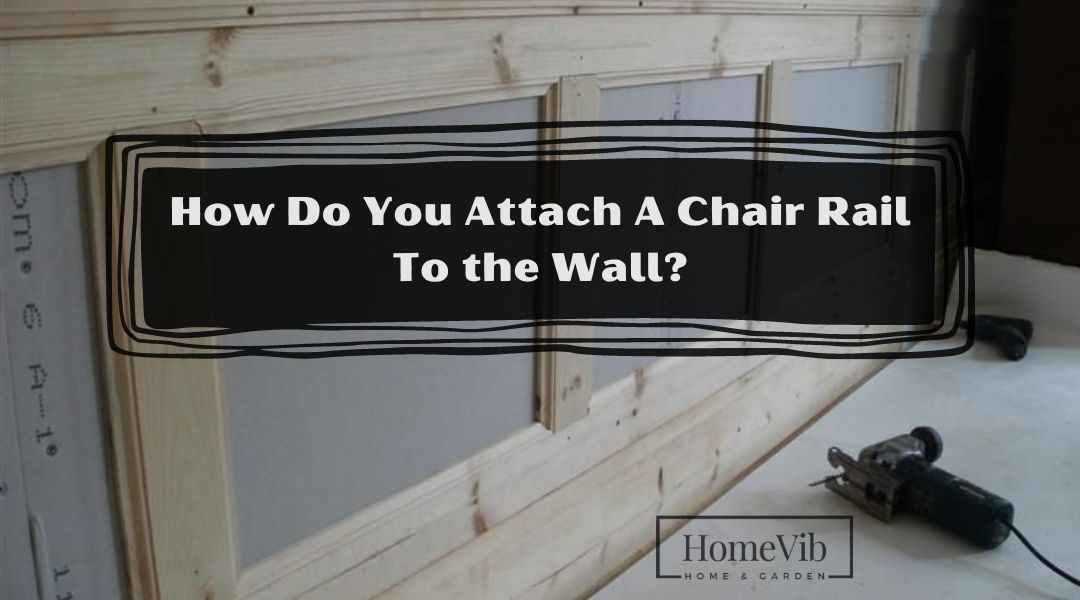To attach a chair rail to the wall, start by measuring and marking the desired height for the chair rail along the wall, and locate wall studs using a stud finder.
The chair rail serves both a functional and decorative purpose, protecting the wall from chair backs and other furniture while adding a touch of elegance to the room.
This guide will explore the step-by-step process of attaching a chair rail, covering the necessary tools, materials, and tips to ensure a successful and aesthetically pleasing installation.
How Do You Attach a Chair Rail To the Wall?
Attaching a chair rail to the wall is a straightforward process requiring careful planning and execution. Follow these step-by-step instructions to ensure a successful installation of your chair rail:
- Gather the Necessary Tools and Materials: Ensure you have all the required tools and materials before installing. You will need a measuring tape, level, pencil, miter saw, nails or screws, a hammer or drill, adhesive, wood putty, and a sanding block.
- Measure and Mark: Use a measuring tape to determine the appropriate height for your chair rail. Typically, chair rails are installed around 32 to 36 inches above the floor, but this can vary depending on the room’s dimensions and aesthetic preferences. Once decided, mark the height using a pencil along the entire wall length.
- Find Wall Studs: Locate the studs using a stud finder to ensure a secure and sturdy attachment. Mark the stud locations above the marked chair rail height, as this is where you’ll attach the rail.
- Cut the Chair Rail: Measure the wall length and cut the chair rail molding using a miter saw. For an aesthetically pleasing finish, cut the ends of the chair rail at 45-degree angles for mitered corners or 90-degree angles for butt joints.
- Dry Fit the Chair Rail: Before permanently attaching the chair rail, perform a dry fit by placing the cut molding along the marked line on the wall. Ensure the molding fits properly and adjust if necessary.
- Apply Adhesive: Apply a strong adhesive to the back of the chair rail, especially if the molding is lightweight or made of materials like MDF or composite. This will provide additional stability and prevent warping over time.
- Install the Chair Rail: Carefully position it along the marked line on the wall, ensuring it aligns with the stud marks. Press the molding firmly against the wall to secure it in place.
- Nail or Screw the Chair Rail: Use finishing nails or screws to fasten the chair rail to the wall studs for added strength and durability. If you’re using nails, countersink them slightly below the surface using a nail set. Alternatively, use screws with the appropriate pilot holes.
- Fill and Sand Nail Holes: Fill the nail or screw holes and any gaps in the joints with wood putty. Once dry, sand the filled areas to create a smooth and seamless finish.
- Paint or Stain: Finally, paint or stain the chair rail to complement the room’s decor. Apply multiple coats if necessary, allowing sufficient drying time between each coat.
Can You Glue the Chair Rail To the Wall?
Max Strength Clear Construction Adhesive
Gluing the chair rail to the wall is a common and effective method, especially for lightweight materials like MDF or composite.
It offers a secure bond, a cleaner finish without visible fasteners, and installation flexibility.
To glue the chair rail, clean the wall, apply adhesive generously, press the molding in place, and use temporary supports if needed.
However, combining adhesive with nails or screws may be a better option for heavier chair rails or areas with high humidity.
Always follow the manufacturer’s instructions for the adhesive and chair rail material to ensure a successful and long-lasting installation.
How Do You Install the Chair Rail On Stairs?
Installing a chair rail on stairs can elevate the visual appeal of your staircase while providing added protection to the walls from potential scuffs and scrapes.
However, this task requires precise measurements and careful execution to ensure a seamless and professional result.
Here’s a guide on how to install a chair rail on stairs:
- Measure, Plan, and Choose Material: Measure the total length of the staircase and select a chair rail material that complements your decor. Wood, MDF, or composite moldings are popular choices.
- Cut and Dry Fit: Use a miter saw to fit the chair rail pieces, considering any angles or corners. Perform a dry fit to ensure a snug and precise fit.
- Mark Height and Find Studs: Determine the chair rail height (around 32 to 36 inches) and mark it consistently along the stairs. Use a stud finder to locate wall studs.
- Apply Adhesive and Install: Apply strong adhesive to the back of the chair rail and position it on the marked line. Press firmly against the wall to secure it in place.
- Use Nails or Screws (Optional): Use finishing nails or screws to secure the chair rail further for added strength—countersink nails for a clean finish.
- Fill, Sand, and Finish: Fill holes or gaps with wood putty, then sand the filled areas for a smooth surface. Paint or stain the chair rail to match the decor.
How Do You Finish the Edge Of a Chair Rail?
Finishing the edge of a chair rail is an essential step to achieving a polished and professional look.
There following are standard methods to finish the edge of a chair rail, depending on the design and material of the molding:
Mitered Corners
The most common and elegant finish for chair rail installations involving corners is a mitered corner.
To achieve this, cut the ends of the chair rail at a 45-degree angle using a miter saw. When two pieces meet at the corner, their mitered edges will form a clean and seamless joint.
Butt Joints
In cases where you want a simple finish, you can use butt joints. For butt joints, the ends of the chair rail pieces are cut at a 90-degree angle, resulting in a straightforward but slightly more visible joint.
Coping
Coping is a method to finish the interior corners of chair rail moldings. Instead of cutting a 45-degree angle, one piece of molding is cut to fit the contour of the adjacent piece’s profile.
This creates a snug fit between the two parts, concealing any imperfections at the joint and resulting in a clean and professional finish.
Return Ends
You can finish the edge with a return end if your chair rail terminates at a wall instead of a corner.
To do this, cut the end of the chair rail at a 90-degree angle and then cut another small piece at a 45-degree angle.
Attach the small amount to the end of the chair rail, creating a finished look without the sharp edge.
Use a Chair Rail Cap
Chair rail caps are decorative moldings designed to fit over the chair rail ends, providing a clean and attractive finish.
They come in various designs and materials, allowing you to choose one that complements your chair rail and room decor.
Sand and Paint
Regardless of the finishing method, sand any cut edges of the chair rail to ensure a smooth surface.
After sanding, paint or stain the chair rail to match the decor, enhancing its appearance and protection.
What Angle Do You Cut Chair Rail Corners?
Chair rail corners are typically cut at a 45-degree angle. When two pieces of chair rail meet at a corner, cutting both ends at a 45-degree angle allows them to fit together seamlessly, creating a clean and professional joint.
This mitered corner technique is commonly used to achieve an elegant finish in chair rail installations.
What Kind Of Molding Is Used For Chair Rail?
Chair rails serve as decorative elements and protect walls from damage caused by chair backs and other furniture. Let’s explore the most common types of molding used for chair rails:
- Wood Chair Rail: Wood chair rails can be stained to showcase the natural beauty of the wood or painted to match the room’s decor. It comes in various wood species, such as oak, pine, maple, and poplar, each offering unique grain patterns and colors.
- MDF Chair Rail: Medium Density Fiberboard (MDF) chair rails are engineered wood products that offer a cost-effective and versatile option. MDF is smooth and easy to work with, making it an excellent choice for DIY installations.
- PVC Chair Rail: PVC chair rails are highly moisture-resistant and are ideal for areas prone to humidity, such as bathrooms and kitchens. They are easy to clean and maintain and can be painted to match the room’s color scheme.
- Composite Chair Rail: Composite chair rails combine materials, such as wood fibers and plastic, to create a sturdy and durable option.
- Metal Chair Rail: Metal chair rails, typically made of aluminum or stainless steel, offer a modern and industrial aesthetic. They are durable and can add a sleek and contemporary touch to any space.
- Plaster Chair Rail: Plaster chair rails provide a more traditional and ornate appearance. They are often used in historic or classical interiors to add a touch of elegance and historical charm.










